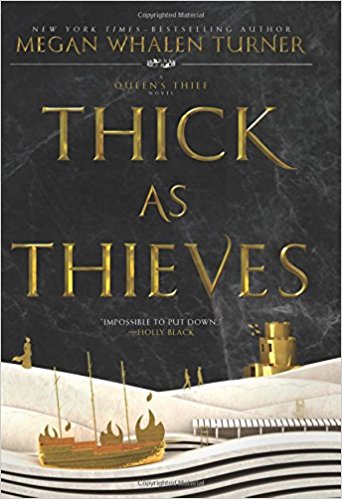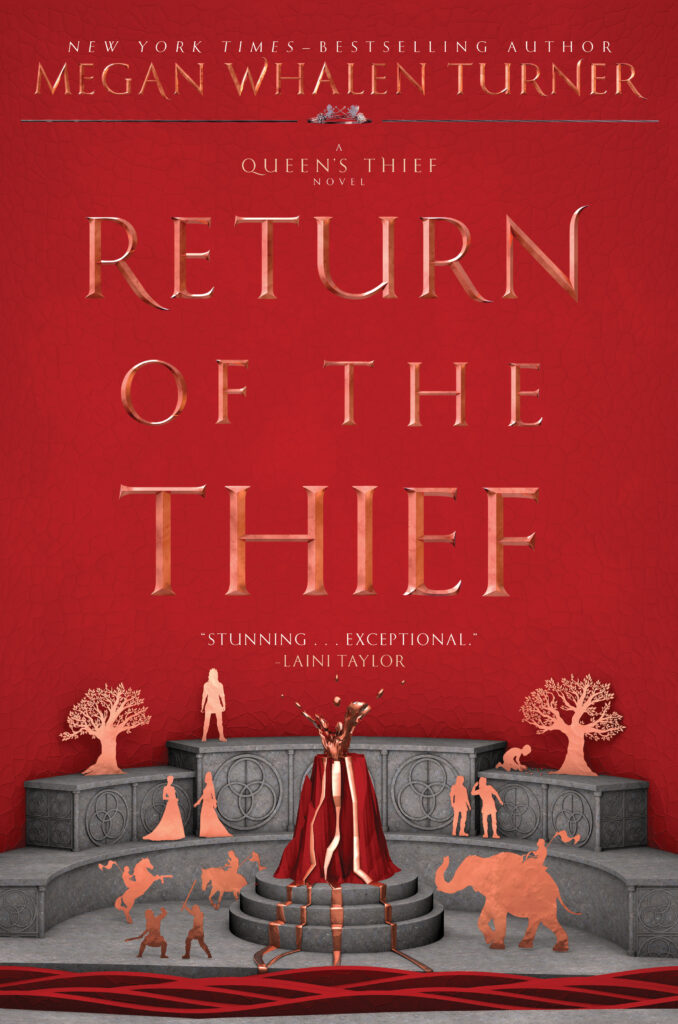Thick as Thieves came out this year (2017) (Yay! I read it twice in a row!) and I’ve been enjoying re-reading Megan Whalen Turner’s The Queen’s Thief series. She’s making me think about the story from an outsider’s perspective.
Megan Whalen Turner’s beloved Eugenides character is showcased in a way that reminds me of Dorothy Dunnett’s well-loved Francis Crawford of Lymond. Both authors have a lovely, twisty plotting style with snappy dialogue to warm any reader’s heart.
Dorothy Dunnett rarely gives the reader an inside glimpse of Lymond’s mind or heart. Rife and contradictory speculation lets the reader discover Lymond’s true character, just the way we get to know people in real life.
Elegant Use of Point of View Over a Long, Complex Series
In The Queen’s Thief series, Megan Whalen Turner moves the point of view progressively further away from her key character, Eugenides.
The Thief is told in the first person by the Queen’s Thief.
The Queen of Attolia seems to be third person omniscient because we get interior thoughts from both the Thief and from the Queen.
The King of Attolia is told by an Attolian guard who resists being won over by the new King of Attolia.
A Conspiracy of Kings is told from the King of Sounis’s point of view.
Thick as Thieves is a quest story about an Attolian guard told from the point of view of Kamet, the head slave of the Mede Emperor’s nephew, as he figures out what the King of Attolia is really like. The relationship that develops reminds me of the one between Captain Jack Aubrey and Stephen Maturin in Patrick O’Brian’s Master and Commander.
What are the storytelling advantages of an outsider perspective?
- It makes the reader “an accomplice” and works especially well in a series where we already know and love the main character.
“And this is the genius of Megan Whalen Turner because in book 3, we, the readers, are Eugenides’s accomplices. We sit back and wait for the coin to drop for everybody else as it has dropped for us in books 1 and 2.” —The Book Smugglers
2. The outsider can question what the main character never says (or thinks about). The reader gains a guide and a companion in the story, a Watson to a closed-off and brilliant Sherlock Holmes. Megan Whalen Turner’s Costis does this effectively, as does Kamet.
3. Misdirection, fame, and mystery. An obvious advantage (and disadvantage): we see what the main character looks like from the outside. Megan Whalen Turner uses this to great effect in The King of Attolia when we see what Eugenides looks like to everyone else.
Interestingly, Eugenides’ relationship to the god of thieves is always shown to the reader from the outside. This conveys mystery better than any internal thought process could.
4. Someone to carry the ball. A story that ends in a tragic death can only be told by an outside narrator. Not sure if that’s an advantage. Someone has to be left to do the wrap up. Unless you’d like a Shakespearean monologue after death delivered by your main character. Thankfully, Megan Whalen Turner hasn’t done this yet. (MWT–Please don’t kill off your beloved characters!)
Read More About Brilliant Author, Megan Whalen Turner
Here’s the link to the whole review by The Book Smugglers which says what I’ve been trying to say about the change in narration and the power of these books, so I’ll stop now. 🙂
What I really want to say is: Read the books!
Here’s another fun mini-interview with Megan Whalen Turner about The Queen’s Thief series. And another one.
Here’s one that came out after The Return of the Thief.
Happy reading!






